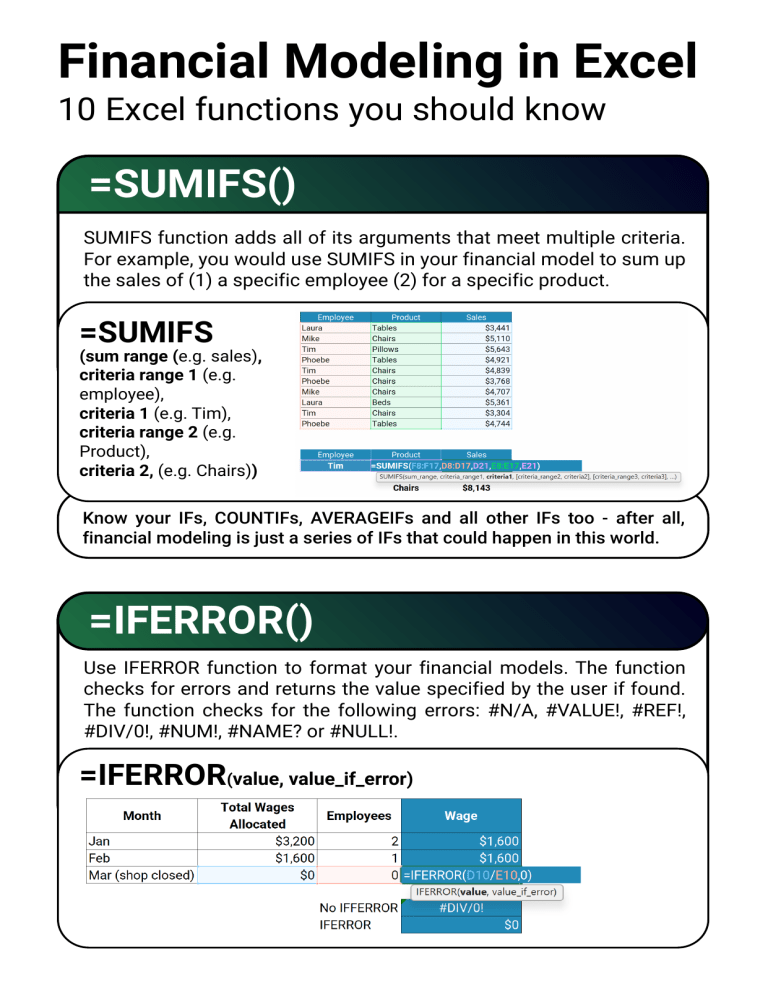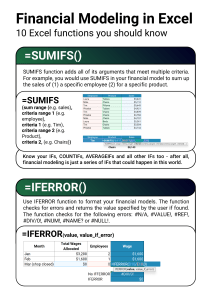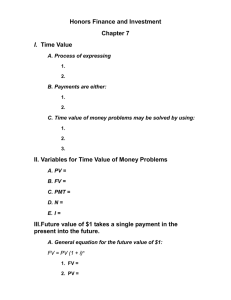
Financial Modeling in Excel 10 Excel functions you should know =SUMIFS() SUMIFS function adds all of its arguments that meet multiple criteria. For example, you would use SUMIFS in your financial model to sum up the sales of (1) a specific employee (2) for a specific product. =SUMIFS (sum range (e.g. sales), criteria range 1 (e.g. employee), criteria 1 (e.g. Tim), criteria range 2 (e.g. Product), criteria 2, (e.g. Chairs)) Know your IFs, COUNTIFs, AVERAGEIFs and all other IFs too - after all, financial modeling is just a series of IFs that could happen in this world. =IFERROR() Use IFERROR function to format your financial models. The function checks for errors and returns the value specified by the user if found. The function checks for the following errors: #N/A, #VALUE!, #REF!, #DIV/0!, #NUM!, #NAME? or #NULL!. =IFERROR(value, value_if_error) Financial Modeling in Excel 10 Excel functions you should know =XIRR() Internal rate of return metric is needed to find out the annual growth rate of an investment. The higher the IRR, the better the investment (keeping all other factors the same, of course). IRR is good for comparing different investment opportunities. =XIRR(cash flow values, dates of cash flows) =XNPV() Finance is money and we all know that money today is worth more than tomorrow. Financial analysts oftentimes have to calculate the value of an investment/company/project in today’s terms. =XNPV(discount rate, cash flow values, dates of cash flow) Unlike IRR and NPV, XIRR and XNPV functions allow for payments at irregular intervals Financial Modeling in Excel 10 Excel functions you should know =PMT() PMT function calculates the payment for a loan based on constant payments and a constant interest rate. You have to know the present loan value, number of periods and the interest rate. PMT, PPMT and IPMT functions are needed to figure out annuity loan repayments (e.g. mortgage) =PMT(interest rate, number of periods, present value) =PMT() calculates periodic payment for a loan in total =PPMT() =IPMT() calculates calculates the the payment interest on the princi- payment on pal for a loan the loan =SLOPE() If you’re into investment banking, at some point you’ll have to calculate the Beta of a stock, which means volatility. By using the SLOPE function in Excel, you’ll find it easily by using the returns of the stock and the comparative benchmark index. =SLOPE (% of equity change range, % range of change of index) Financial Modeling in Excel 10 Excel functions you should know =XLOOKUP Lookup functions are a must to know for any modeler. They are used to quickly and easily find data in a table, for example, to find the amount sold by an employee, ID number, and thousands of other things. =XLOOKUP(what do you want to look up, where can it be found, what do you want to return) =INDEX() & MATCH() Sometimes, XLOOKUP won’t do the job, as it can only compare one array with another one. Index and Match function combination can look up values in the whole table - it’s 2 Dimensional. =INDEX (what you want to return, =MATCH (what are you looking for, where can it be found) Financial Modeling in Excel 10 Excel functions you should know =EOMONTH() EOMONTH function finds the last day of the month after you add a specific number of months to a date. It’s useful for calculating maturity dates or due dates that fall on the last day of the month. It also aids in setting up your financial model. =EOMONTH (start_date, months you want to add/substract) =EDATE() will aid in adding months to a specified start date =SEQUENCE The SEQUENCE function allows you to generate a list of sequential numbers in an array. SEQUENCE function works great if you need to generate a list of 10,000 numbers in a column. =SEQUENCE (number of rows you want to generate, number of columns you want to generate, starting point, step)



